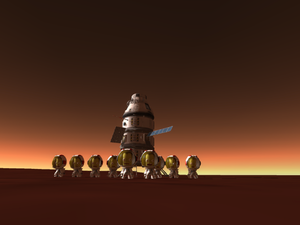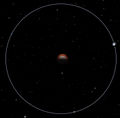Difference between revisions of "Duna"
Aceassasin (talk | contribs) (→Changes) |
m (Added extra infomation) |
||
| Line 11: | Line 11: | ||
Duna has several craters, but they appear quite eroded, presumably from wind. | Duna has several craters, but they appear quite eroded, presumably from wind. | ||
| − | There are several [[w:Lunar maria|maria]] (large regions of dark soil) at exactly 0 meters altitude. Their flatness and low altitude which allow for more aerobraking make them easy but boring landing locations. | + | There are several [[w:Lunar maria|maria]] (large regions of dark soil) at exactly 0 meters altitude. Their flatness and low altitude which allow for more aerobraking make them easy but boring landing locations. These could've been lakes when the planet may have had liquid on it's surface in the past |
Duna's surface contains [[List of easter eggs#Duna|anomolous features]]. | Duna's surface contains [[List of easter eggs#Duna|anomolous features]]. | ||
Revision as of 04:19, 11 August 2013
Duna is the fourth planet of the Kerbol star system. It is the Mars analog for Kerbal Space Program and is mostly red with polar icecaps. It has one natural satellite, the moon Ike. Due to Ike's size and proximity, Ike and Duna are tidally locked to each other.
With proper aerobraking, a round trip from Kerbin to Duna's orbit and back requires roughly 1700 m/s of delta-v, less than a round trip to any other planet. Duna is often the easiest planet to achieve encounters because of a low orbital inclination.
Contents
Topography
Duna's terrain ranges in altitude from 23 to 4740 meters. Its mountainous ranges are a peril to landing craft, especially considering the thin atmosphere, where very little aerobraking can be done safely. Duna's icy poles are quite expansive and are the result of a thin atmosphere.
Duna has several craters, but they appear quite eroded, presumably from wind.
There are several maria (large regions of dark soil) at exactly 0 meters altitude. Their flatness and low altitude which allow for more aerobraking make them easy but boring landing locations. These could've been lakes when the planet may have had liquid on it's surface in the past
Duna's surface contains anomolous features.
Atmosphere
Duna's atmosphere begins at 41,446 m. It is only 20% as dense as Kerbin's at altitude 0 and is even less dense (relative to Kerbin) at higher altitudes. This effect becomes especially noticeable at Duna's highest points, where its atmosphere is only 21% as dense as its atmosphere at altitude 0. (For comparison, on Kerbin, the atmosphere at the highest peaks is 45% as thick as at sea level.) This lack of density will cause parachutes to semi-deploy much lower, just over 10km for the Mk25 and just under 9km for all the other parachutes.
Landing
When landing on Duna, aerobraking can reduce orbital and surface velocity greatly, saving fuel. For best results, an aerobraking maneuver should maximize time spent in the atmosphere by entering at a shallow angle and aiming for a landing location in a low-lying area.
Like all atmospheres in the game, Duna's atmosphere fades exponentially with increasing altitude (with a scale height of 3000 m). In general, the atmospheric pressure on Duna at an altitude expressed in meters is:[1]
Parachutes work at lower efficiency than on Kerbin, making powered descent necessary when landing from orbit (unless you have enough drag/parachutes).
Flying
The atmosphere of Duna might be thin, but on heights below 5 km it is thick enough that wings can generate enough lift to make aerodynamic flight possible. Jet engines don't work due to lack of oxygen, but other propulsion methods work well. Performing a horizontal landing with a plane is also possible.
Starting
An ascent to Low Duna Orbit from the surface typically requires around 1500 to 2000 m/s in Delta-V, leaving you in an orbit at 42km altitude traveling at roughly 950 m/s.
The following table gives terminal velocities at different Duna altitudes. These are also the velocities at which a ship should travel for a fuel-optimal ascent from Duna, given the game's model of atmospheric drag.[2]
| Altitude (m) | Velocity (m/s) |
|---|---|
| 0 | 212 |
| 1000 | 231 |
| 2000 | 252 |
| 3000 | 274 |
| 5000 | 324 |
| 8000 | 418 |
| 10000 | 495 |
| 13000 | 638 |
| 15000 | 756 |
| 20000 | 1.16×103 |
Tracking Station Info
Also known as the red dot that you can see if you squint really hard, Duna has long been a wonder to Kerbalkind. The planet has been held in much awe, due to its striking red color and stark contrast to the color green.
Orbital Statistics
The geosynchronous orbit of Duna is at an altitude of 0.00 m above Duna. The speed of the satellite is 0.00 m/s and it has an orbital period resonating with 1 Duna day (18.2 hours or 65517.859375 seconds). However, this is the same altitude at which Ike orbits, so unless a ship's orbit is perfectly precise, it will eventually be captured by Ike.
For a semi-synchronous orbit of ½ Duna day (9.1 hours or 32758.9295 seconds) an orbit of 0.00 m above Duna is needed with a velocity of 0.00 m/s.
Observation of Ike
Ike's orbit keeps it directly above a short range of Duna longitudes. The average Duna longitude where Ike tends to stay directly above in the sky (at the Zenith) is 6 degrees east, but the exact longitude oscillates between about 2 degrees and 10 degrees east due to the eccentricity of Ike's orbit. This eccentricity also makes Ike appear to grow slightly larger and smaller to an observer on the surface of Duna. The latitude for which Ike is in the Zenith also oscillates between 0.2 degrees south and 0.2 degrees north due to Ike's orbital inclination, making Ike appear to rotate upwards and downwards as viewed from the surface, but due to the extremely small orbital inclination, this effect is nearly imperceptible. These phenomena together are known as libration. Due to the oscillation in Ike's position above the horizon, areas from 88°W to 80°W and 92°E to 100°E on Duna can observe Ike rise and set at least partially across the horizon, as can any areas north of 89.8°N or south of 89.8°S.
Interplanetary Travel
From altitude orbit around Duna, the amount of delta-V needed to reach the orbits of other celestials is as follows:
| Body | Delta-V | |
|---|---|---|
| Ike | ~300 m/s | |
| Kerbin | ~620 m/s | |
| Dres | ~820 m/s | |
| Eve | ~1080 m/s | |
| Jool | ~1350 m/s | |
| Eeloo | ~1580 m/s | |
| Moho | ~2100 m/s | |
Reference Frames
| Time warp | Minimum Altitude |
|---|---|
| 1× | Any |
| 5× | 50 000 m (above the atmosphere) |
| 10× | 50 000 m (above the atmosphere) |
| 50× | 60 000 m |
| 100× | 100 000 m |
| 1 000× | 300 000 m |
| 10 000× | 600 000 m |
| 100 000× | 800 000 m |
Gallery
Duna at sunrise
Changes
- Art Pass
- Minor art pass
- Initial Release
Trivia
- Duna's name may be either a reference to its desert landscape or a shout-out to the Frank Herbert novel Dune.
- The low-lying areas near Duna's equator make a shape resembling Europe.
- On the surface of Duna, there is a large monument carved in the likeness of a Kerbal face, alluding to the infamous "Face of Mars" discovered in the Cydonia Mensae region of Mars during the 1970's.
- Buried deep under the surface, there is a small camera, similar to the design on the Pathfinder rover.
- One anomalous feature on Duna is a small, pyramid-like hill emitting an SSTV signal. When decrypted, it shows a diagram-like image of three figures standing next to the hill itself, implying that Duna was once inhabited or visited before.
Notes
- ↑ A nuclear engine has a specific impulse of 220 in 1 atm, 800 in vacuum, and the following at various Duna altitudes:
altitude (m) 2 100 300 500 1460 2420 3000 4272 5000 10000 specific impulse 684.1 687.8 695.1 701.8 728.7 748.2 757.3 772.1 778.1 795.9 - ↑ http://forum.kerbalspaceprogram.com/showthread.php/6664-Mini-challenge-max-altitude-with-this-supplied-spacecraft?p=100912&viewfull=1#post100912












